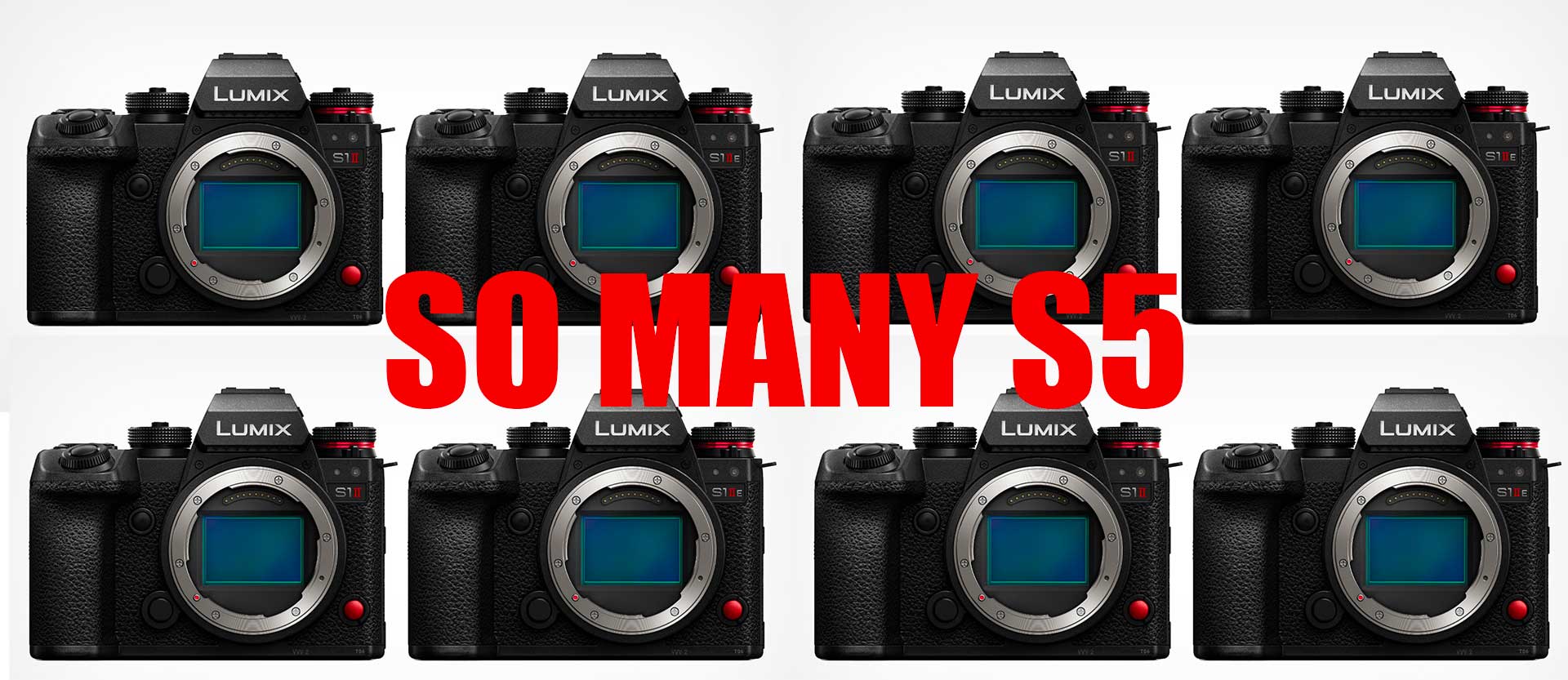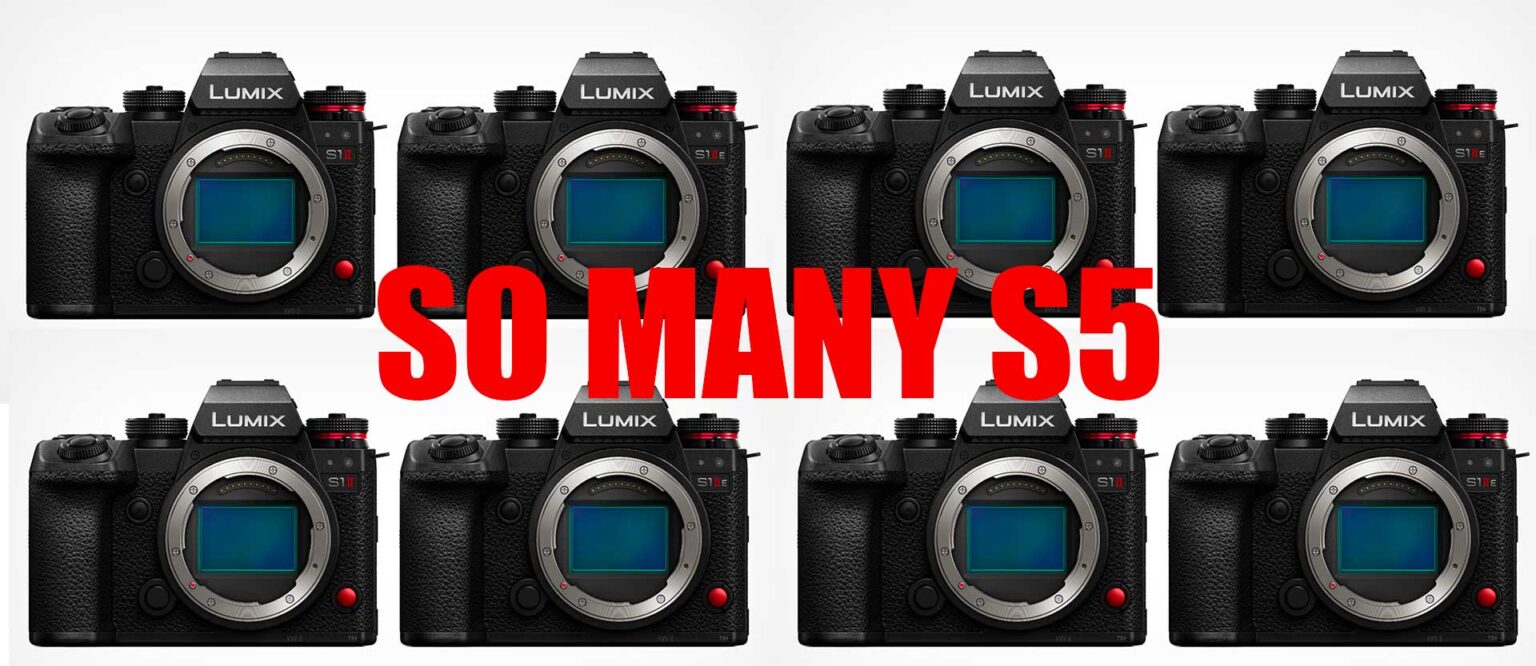
Are Panasonic open to some honest feedback?
I can only hope so.
My current camera collection is addict-level huge, but I use my Nikon Z8, Fujifilm GFX 100 and an X-Pro3 the most. I also have a lot of fun with my Sigma Fp-L, but only with Leica M mount lenses and not the native glass. I had a Sony a1, but sold it (and regretted it), that one will be coming back the moment the used price drops to £3k.
Speaking of £3000, that’s a lot of money for consumer electronics in 2025 isn’t it? When I was emailed the wrong S1 II pricing information by the PR agency Panasonic is using to contact me (they no longer do directly – the price for being a fact-based journalist in 2025), I queried it and it seems they had sent the wrong pricing to everyone and mixed up the S1 II and S1 IIE.
This is truly amateur hour stuff but it points to a deeper issue with Panasonic’s strategy and why they might leave the camera market before too much longer.
EOSHD has been going 15 years from the start of the mirrorless filmmaking revolution with the Panasonic GH1 in 2010 and of course the DSLRs, starting with the 5D Mark II. Some of you will know the history of it, and recognise that Panasonic have been one of the most creative in terms of products.
The Panasonic GH1 was pioneering, the first hybrid mirrorless camera aimed at filmmakers, followed-up with a nice image quality improvement on a very fast product cycle, with the GH2 and GH3. In 2014 came the GH4 bringing 4K to the masses first before even Sony or Canon had thought of a reply. In the meantime Panasonic were keeping themselves busy with Leica as well, gearing up for the 2015 release of the full frame Leica SL, which they co-engineered. Despite all this Osaka still found time to give us the first 4K high-end compact with the LX100 and charged consumer prices for the GH4 and GH5, unlike Canon with the $15k 1DC. The 2018 launch of the original S series full frame Panasonic cameras capped an impressive 8 years in the mirrorless market.
Now I don’t blame the old guard for retiring after such an amazing run, if thats what some of the most senior Japanese geniuses have done. Same goes for the marketing people too. But you have to make sure those replacing you know their stuff.
For some reason, since the full frame cameras launched in 2018, the product planning has been a total mess in my opinion. The move to full frame was done without a reliable autofocus system which was a terrible error and the initial cameras were too big and heavy compared to the Sony Alpha and Panasonic GH series.
The full frame cameras came at the cost of curtailing sales of their existing Micro Four Thirds cameras, and the GH6 bombed.
I’m sorry Panasonic but the S1 II and S5 II are just so derivative.
Where is the full frame equivalent to Panasonic’s lovely rangefinder-style GX9?
I’ll give you a clue, it ain’t the S9 as that has no EVF or mechanical shutter, and it’s too chonky. It’s aimed at social media influencers and beginners.
Where is the mould-breaking S1H II we have all been dreaming of, finally a solution to fucking exposure for fucks sake at 180 degree shutter, I am starting to think an eND filter is just completely beyond all the Japanese companies.
Where is the answer to China? Their rise to the very top of the imaging technology tree with AI and smartphones has gone completely without a reply from Japan.
Where’s Panasonic with the S1 II and S1R II back in 2020 when Canon brought out the EOS R5 and R6, where were they in 2021 when the 8K, stacked sensor Sony a1 came along shortly followed by the Nikon Z9? They have let the competition stack up unanswered for 7 years since the original S1 launch.
But now in 2025 it’s suddenly party time, or is it attack of the clones?
The S5 II seems to have been cloned and now all of a sudden have FIVE almost identical cameras, all but one are standard 24 megapixel cameras, in the same body design! This many similar models are confusing for customers and just creates a load of cannibalisation. The S5D, S5 II, S5 IIX, S1 IIE and S1 II only seem to compete against each other. Only one of these needed to exist and that was the S1 II. It needed to exist sooner, at least 3 years sooner instead of the silly original S5, not ages later after the Canon EOS R6 II and Sony a7 IV had joined the party.
Throw in the S1R II and Panasonic S9 and this brings the total number to 7 “2nd generation” L-mount cameras in the space of 2 years.
Crazy.
The differences would take a heck of a lot of explaining to the average customer.
I also think that although the Lumix S9 is a fun little camera, it was the worst marketing and high-profile launch I’ve ever seen for as long as I’ve been around with EOSHD (in 15 years that is). It was confused, disorganised, they invited the wrong people and nobody had really asked for an S9 anyway.
Was this camera some sort of knee-jerk reaction to the rise of content creators and vloggers? OK, fine, but had Panasonic put a bit more thought into this new range, they’d have realised that a higher-end camera with EVF and mechanical shutter would have finally given all those rangefinder form factor aficionados a reason to buy a Panasonic.
In the Micro Four Thirds days, they had a shower of enthusiast level rangefinder-style cameras with EVFs and mechanical shutters and now in the full frame era they have a big fat zero. None of this makes any sense.
Why was this popular form factor leapt upon by Panasonic and then abandoned, seemingly for no reason?
You can only assume that Panasonic thought that an Instagram camera could gain them significant sales. I don’t think the strategy has worked. A full frame GX8, or GX9 style camera, think of the incredible interest that would have generated in the era of the Fujifilm X100 VI, X-Pro3 or Sony a7c II, and not just from across the spectrum of different camera-brand users, but from Panasonic’s own customers – a ton of GX85, or GX9 users are STILL waiting for a full frame upgrade with the same compact body and rangefinder ergonomics, and the S9 was evidently not it.
The other major problem I have with the new cameras is the pricing. With the kit lens we are talking £3600 in the UK for the S1 II and the S1 IIE with kit lens is £3000 once you swap the figures around in the PR agency’s email so that they stand upright. The body-only prices are also too high, at £2899 and £2399 respectively. Just as worryingly this has been the case with the Micro Four Thirds G9 II as well, and the GH7. Too high.
Panasonic have built their reputation on value for money. What’s happened?
You can’t blame tariffs, as these are the UK prices. The real US prices are likely to be even higher once the cameras ship, depending on what the political rollercoaster is doing there.
In the case of the G9 II, how many people are clamouring to spend £2k on a 2x crop sensor camera? You can get a very good mid-range full frame camera for less.
How many are going to want to commit £3000 (£3600 with kit lens), for a mid-range L-mount camera? It’s not a Leica SL3. It’s basically an S5 with a faster sensor. L-mount is not Sony E. The much more popular lens mounts are E, Nikon Z and Canon EOS R. Added to that, the fact that the closest competitors to the S1 II are all a lot cheaper (Nikon Z6 III) and came out much earlier spells trouble… The Nikon Z6 III and Canon EOS R6, even the good old Sony a7 IV have been out for ages and already discounted at much more attractive prices than £3000.
But 2.4:1 cinemascope is nice, I guess?
No really, I do like real-time LUTs. Love the 2.4:1 look. In stills mode I love the Panasonic “XPAN” style wide aspect ratios, great for framing up a RAW or JPEG, and Fujifilm still don’t offer this (such a simple thing!) on any XF cameras, only on the medium format GFX models.
I like Panasonic’s commitment to anamorphic modes.
I like the introduction of 32bit audio. I love V-LOG, the image quality is very good. Panasonic’s codecs are excellent, such a wide array of modes.
Clearly somebody in engineering is doing the right thing, only for the product planners and marketing to make a total mess of it.
Anyway, about the pricing… if you are Canon, Sony or Nikon you’d probably get away with it, but Panasonic?
£3K for an S1 II?
They don’t have anything with a flagship sensor in it, they have no stacked sensor, no proprietary internal RAW codec like N-RAW or BRAW, and then someone made the silly decision to have the middling S5 II form the basis of all future camera bodies.
Then there’s the small matter of autofocus. Out of all the major mirrorless brands, the latest Panasonic cameras are still only 5th behind Sony in 1st, Nikon in 2nd, Canon in a close 3rd overall and you could say OM System in 4th as well as the OM-1 II is very good in this regard. Only Fuji and Sigma have dodgier overall autofocus systems and Pentax is still bouncing light off mirrors like it’s the 18th century.
Is the S1 II a badly designed, poorly spec’ed camera in 2025? No, it’s merely an overpriced mid-range camera that we waited 7 years for, and during that time the other brands have been going gangbusters with stacked sensors, 8K 60p internal RAW and cutting edge autofocus.
Panasonic will have to do more, if they want to avoid spiralling into sales oblivion.



